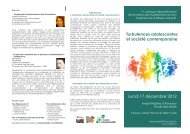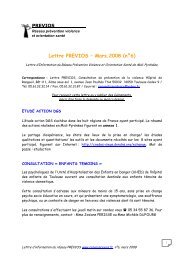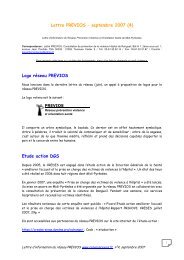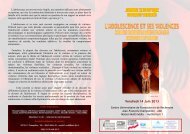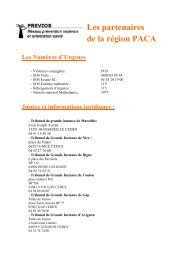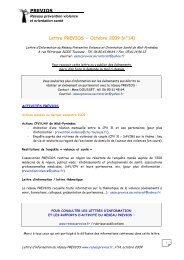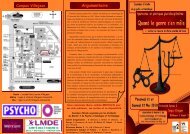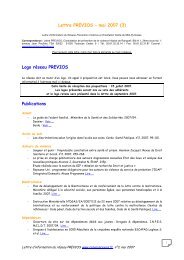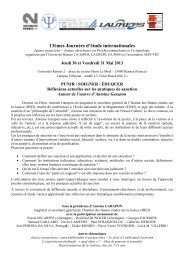Violence de couple - Réseau PREVIOS
Violence de couple - Réseau PREVIOS
Violence de couple - Réseau PREVIOS
- No tags were found...
Create successful ePaper yourself
Turn your PDF publications into a flip-book with our unique Google optimized e-Paper software.
PsychologieToulouse Le MirailLe développement socio-affectif <strong>de</strong>l’enfant âgé <strong>de</strong> 4 à 6 ans exposé auxviolences conjugales. (Dir. : C.Zaouche-Gaudron)SAVARD Nathalie(Document disponible via<strong>PREVIOS</strong>)were led in this research. The first one is about the consequences ofdomestic violence for a group of women benefiting from social support.The i<strong>de</strong>a was to bring a contribution to the results already observed inliterature. The second study is about the caretaking of five women whoexperienced a traumatic event during their <strong>couple</strong> life, and then split upwith their molester. EMDR therapy gives really encouraging results, andit led us to test it with a public more heavily traumatized, who livedintensity and variable violence during many years (study 3). The resultsof the third study highlight the importance of the adaptation of thetherapeutic tools to the problematic of the victim, and the limits of theuse of EMDR with some public, inclu<strong>de</strong>d the victims of domesticviolence. An analysis of the EMDR sessions content allowed us to refineour analyses thanks to a clinical “vignette” showed in study 4. Moreover,people that could not be inclu<strong>de</strong>d in the experimental protocol were allthe same followed up, allowing a reflection around the appropriatenessof the therapeutic method and of the experimental frame to the victimthanks to a case study, also presented in study 4. All these observationswill allow the emergence of suggestions concerning the caretaking of thedomestic violence victimsDans le Nord <strong>de</strong> l’Amérique, <strong>de</strong>puis plus d’une trentaine d’années, lesactions <strong>de</strong>stinées aux enfants exposés aux violences conjugales ainsi queles recherches scientifiques relatives à leur développement n’ont cesséd’évoluer, alors que du coté Européen cette question émerge à peine. EnFrance, aucune étu<strong>de</strong> scientifique en psychologie du développement nes’intéresse, à ce jour et à notre connaissance, au développement <strong>de</strong>l’enfant d’âge préscolaire évoluant dans un tel contexte. Parallèlement,les actions envers ces enfants sont peu nombreuses et largementméconnues. L’objectif <strong>de</strong> cette recherche est d’étudier, dans uneperspective écosystémique inspirée du modèle <strong>de</strong> Bronfenbrenner(1986), l’influence spécifique et combinée du contexte <strong>de</strong> violenceconjugale et du stress maternel sur le développement socio-affectif dujeune enfant âgé <strong>de</strong> 5 à 6 ans. Ainsi, notre étu<strong>de</strong> se propose <strong>de</strong> répondreaux questions suivantes : comment l’enfant d’âge préscolaire sedéveloppe-t-il sur le plan socio-affectif lorsqu’il grandit dans un contexte<strong>de</strong> violence conjugale ? Quels sont les facteurs environnementaux quivont avoir <strong>de</strong>s répercussions sur la relation entre la mère et l’enfant ?Plus précisément, est-ce que le fait pour une mère d’avoir été victime <strong>de</strong>violence conjugale va engendrer chez elle plus <strong>de</strong> stress ? L’attachement<strong>de</strong> la mère et le soutien social qu’elle perçoit vont-ils constituer <strong>de</strong>sressources qui vont venir atténuer le stress maternel et par voie <strong>de</strong>2011© Réseau <strong>PREVIOS</strong> – Mémoires et thèses sur la thématique « violences <strong>de</strong> <strong>couple</strong> », actualisation juillet. 201220





